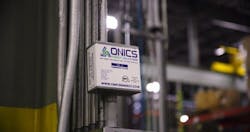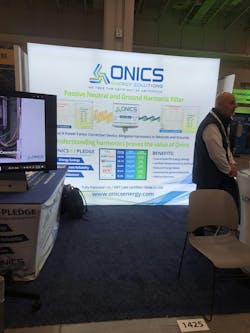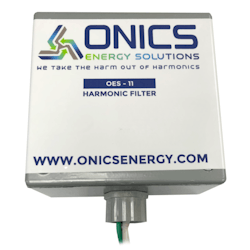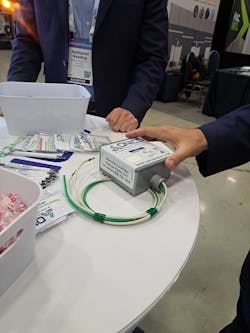Quiet Genius at the Neutral Line: How Onics Filters Are Reshaping the Future of Data Center Power Efficiency
WASHINGTON, DC -- At Data Center World 2025—held in the cavernous Walter E. Washington Convention Center —one theme pulsed throughout the expo floor like a live current: Power.
Not just how to generate it, but how to use it wisely. Amid the ever-expanding catalog of suppliers showcasing gear for data centers large and small, it was hard to miss the green-lit VoltaGrid trailer, symbolic of the generation side of the energy equation. Dave Bell, VoltaGrid’s VP of Data Center and Microgrid Development, even took the keynote stage to hammer home the point that power is no longer just an input for this industry—it’s a lion's share of the whole narrative.
But what about the other side of that power coin—efficiency? That’s where I found myself drawn into a conversation that changed my understanding of how simple, elegant electrical engineering can yield massive opex and ESG gains.
In the depths of the supercharged expo hall, I met Chris LoPilato, Founder and CEO of Onics Energy Solutions, at the company's booth. What I discovered was a story that encapsulates the evolving priorities of modern data center design.
The Small Device with a Big Impact
LoPilato's company isn’t making equipment on the heightened scale of megawatt generators or liquid-cooled racks. Instead, Onics offers a passive neutral and ground harmonic filter—a small, shunt-style, low-pass device that installs in parallel on the “cold” side of a facility’s electrical distribution system. It’s designed to do one thing exceptionally well: skim harmonics off the top, so active electrical gear and transformers don’t have to struggle with unnecessary current distortion.
“It’s simple, it’s passive, and it doesn’t need third-party components or maintenance,” LoPilato told me. “And yet, it can reduce total energy consumption by 5% to over 20%, depending on the facility.”
In a world where megawatts matter, a 10% verified kWh savings across a hyperscale fleet could redefine operating margins.
Further, for data centers and infrastructure tech like Onics filters, ESG relevance usually centers on energy efficiency and emissions reductions, which contribute to meeting sustainability goals and regulatory expectations. So if Onics can reduce power consumption without rewiring or downtime, that's a clear ESG win—especially on the "E" front.
Why Harmonics Matter
In a typical data center, nonlinear loads—like servers, UPS systems, and switch-mode power supplies—introduce harmonic distortion into the electrical system. These harmonics travel along the neutral and ground conductors, where they can increase current flow, cause overheating in transformers, and shorten the lifespan of critical power infrastructure. More subtly, they waste power through reactive losses that don't show up on a basic utility bill, but do show up in heat, inefficiency, and increased infrastructure stress.
Traditional mitigation approaches—like active harmonic filters or isolation transformers—are complex, expensive, and often require custom integration and ongoing maintenance. That’s where Onics’ solution stands out. It’s engineered as a shunt-style, low-pass filter: a passive device that sits in parallel with the circuit, quietly siphoning off problematic harmonics without interrupting operations.
The result? Lower apparent power demand, reduced electrical losses, and a quieter, more stable current environment—especially on the neutral line, where cumulative harmonic effects often peak.
Behind the Numbers: Real-World Impact
While the Onics filters offer a passive complement to traditional mitigation strategies, they aren’t intended to replace active harmonic filters or isolation transformers in systems that require them—they work best as a low-complexity enhancement to existing power quality designs.
LoPilato says Onics has deployed its filters in mission-critical environments ranging from enterprise edge to large colos, and the data is consistent. In one example, a 6 MW data center saw a verified 9.2% reduction in energy consumption after deploying Onics filters at key electrical junctures. Another facility clocked in at 17.8% savings across its lighting and support loads, thanks in part to improved power factor and reduced transformer strain.
The filters work by targeting high-frequency distortion—typically above the 3rd harmonic and up through the 35th. By passively attenuating this range, the system reduces reactive current on the neutral and helps stabilize voltage across the facility’s load side. Because the filters operate in parallel, there’s no risk of downtime during installation, and no disruption to PDU or UPS performance.
Even incremental efficiency gains, multiplied across a hyperscale fleet, translate into major capex and opex wins—not to mention cooling reductions and ESG reporting benefits. In a sector where every watt counts, this small device is quietly making a measurable difference.
Harmonics: The Hidden Drain
So what are we really talking about here? Harmonics—those sneaky byproducts of non-linear loads (like VFDs, UPS systems, LEDs, and your phone charger) that distort the ideal 60 Hz sine wave. These distortions cause resistive (I²R) losses, core transformer stress, skin effect issues, and dielectric heating. All of this leads to energy waste, overheating, and shortened equipment life.
Most discussions about power in data centers focus on sourcing, redundancy, or cooling. But as the NETA World Journal recently highlighted in a peer-reviewed technical study by Dr. Howard Penrose of MotorDoc LLC, neutral and ground harmonics can create system losses and emissions even when your power systems are technically “efficient.”
LoPilato explained it like this: “If you’ve ever touched your phone when it's charging and felt that heat? That’s harmonics. Same thing happens in your power panels. Now imagine that effect multiplied across a 100 MW hyperscale campus.”
Passive Precision
The Onics Passive Harmonic Filter is not a power factor correction device. It’s not in series, and it doesn’t touch the main power line. Instead, it’s parallel, passive, and selective—targeting triplen harmonics and higher-order distortions above 60 Hz while letting the main frequency pass unimpeded.
No active components. No parasitic load. No disruption to service if the device fails.
“Some folks assume this kind of solution has to be complicated or software-driven,” said LoPilato. “But power quality doesn’t always need a dashboard. Sometimes it just needs impedance at the right frequency.”
Installation Without Interruption
Another understated advantage? Installations don’t require full facility shutdowns. Licensed electrical contractors can mount the filters directly onto or adjacent to neutral bus bars, typically at main distribution panels or subpanels.
The process involves de-energizing only the specific panel being worked on, allowing the rest of the facility to stay online—a critical consideration in always-on data center environments. When panel space is tight or retrofitting older infrastructure, Onics accommodates with both internal panel mounting and external NEMA-rated enclosures, tailored to site constraints.
Third-party Measurement & Verification (M&V) confirms energy savings via interval metering data from the electric utility. That independent validation—grounded in rigorous, facility-specific baseline comparisons—is one of the reasons major enterprise and cloud customers are giving Onics a hard look.
Cloud Giant Takes Notice
Apparently, I wasn’t the only one who found the technology compelling.
According to LoPilato, two representatives from one of the largest and most influential cloud operators on the planet stopped by the Onics booth. “They asked questions, took notes, left,” he said. “A day later they came back with smiles and a lot more questions. They’d done the math. They were raving about the energy savings potential.”
Think about that—passive, bolt-on technology that doesn’t require system downtime or fundamental rewiring, catching the attention of a hyperscale giant known for its relentless focus on operational efficiency. That’s more than a testimonial—it’s a glimpse of a paradigm shift.
From Interconnection to Efficiency
If, in the data center industry, the 1990s were about interconnection, and the 2010s were about cooling and density, the 2020s are about total energy intelligence. Generation, yes—but just as critically, optimization. Onics may not have had the flashiest booth or the loudest brand, but they’re walking proof that efficiency is the next frontier of power strategy in the AI data center age.
Data Center World 2025 was proof that our industry is diversifying—and deepening—its supply base. Never before have I seen such a sheer volume of innovative solutions packed into one event. In a landscape once dominated by servers and switches, power is now both the foundation and the differentiator. The crowd around Onics’ booth told me as much.
The quiet buzz around Onics’ filters isn’t just about clever engineering—it’s about a new way of thinking. When a passive, drop-in solution sparks serious interest from some of the world’s largest hyperscalers, it’s clear the conversation around power efficiency is shifting. Big gains don’t always require big retrofits—sometimes, the smartest upgrades are the simplest to deploy.
Learn More:
Onics Energy Solutions Passive Harmonic Filters Overview
NETA World Journal: Neutral and Ground Harmonic Losses Study
This article is part of Data Center Frontier's ongoing coverage of power optimization and energy efficiency innovations in the age of AI infrastructure. Stay tuned for our full DCW 2025 event recap and panel highlights.
At Data Center Frontier, we talk the industry talk and walk the industry walk. In that spirit, DCF Staff members may occasionally use AI tools to assist with content. Parts of this article were created with help from OpenAI's GPT4.
Keep pace with the fast-moving world of data centers and cloud computing by connecting with Data Center Frontier on LinkedIn, following us on X/Twitter and Facebook, as well as on BlueSky, and signing up for our weekly newsletters using the form below.
About the Author
Matt Vincent
A B2B technology journalist and editor with more than two decades of experience, Matt Vincent is Editor in Chief of Data Center Frontier.





